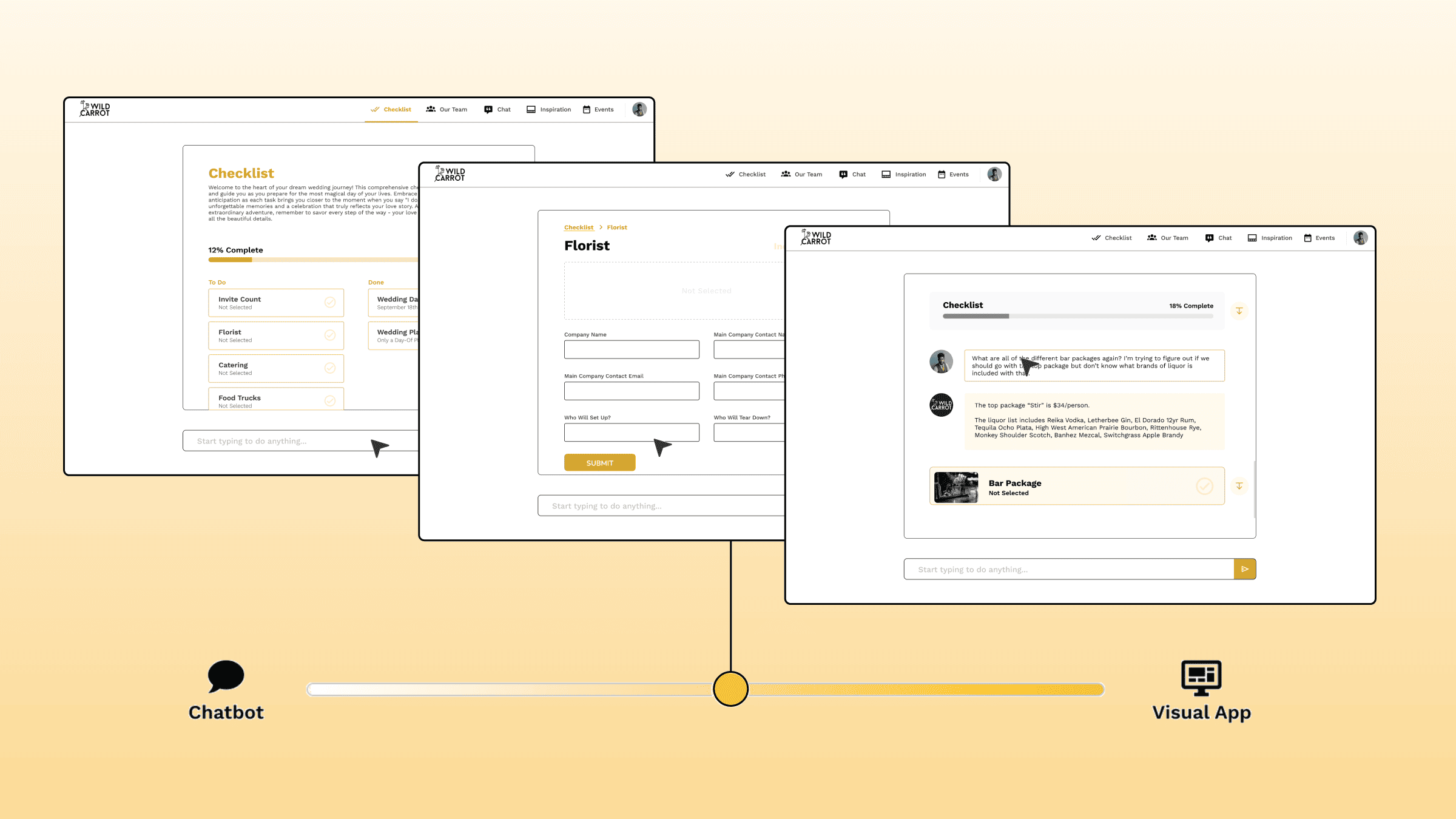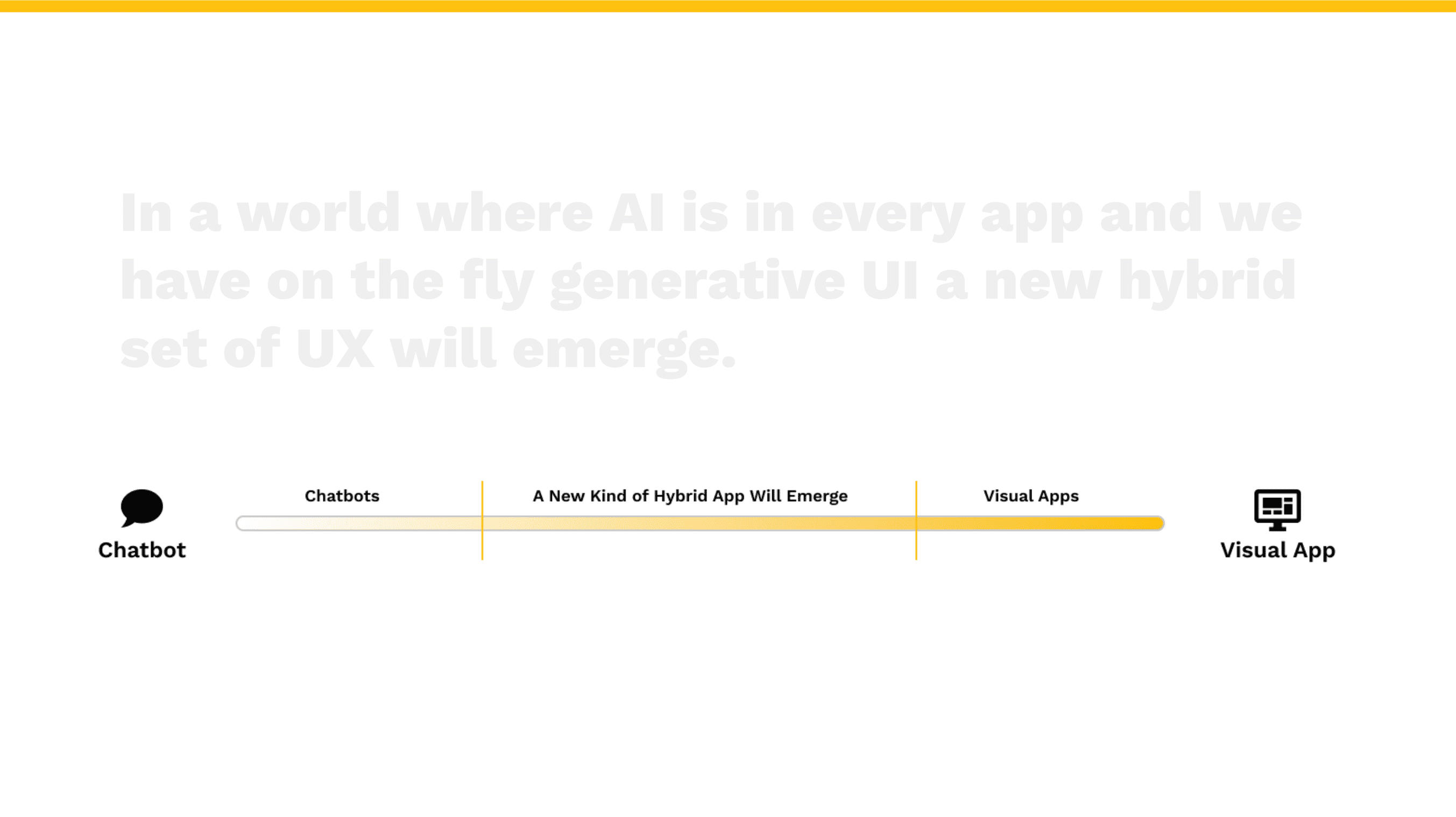© 2025 David Adkin. All rights reserved

AI is transforming both how we design and the experiences we create. As interfaces become more dynamic and generative, UX will evolve into a hybrid of chat-based and visual interactions, adapting in real time to each user. This research project explores the future of UX in an AI-driven world — how design will shift, what new patterns will emerge, and what it means for product teams. Unlike the other projects in my portfolio, this isn’t built software but a thought leadership piece, reflecting a topic I’m deeply passionate about in today’s rapidly changing landscape.
I led the research, exploring how AI will reshape UX through dynamic, generative interfaces. I created mockups to visualize potential interactions and collaborated with industry experts to refine these ideas. This work has been shared as a conference talk, sparking discussions on the future of AI-driven design. Through research, iteration, and expert feedback, I aimed to define emerging patterns and challenges in this evolving space.
Just as software had to evolve from desktop-first to seamlessly adapting across mobile and tablet, AI-driven experiences will soon become an expected standard. Users are rapidly developing AI prompting skills, and as generative UI advances, apps will shift from static interfaces to dynamic, real-time design. Today, AI can generate basic screens from descriptions — but what happens when it can build fully interactive interfaces on the fly? As chat-based AI and generative UI converge, the line between chatbots and traditional visual apps will blur.

Before looking ahead, it’s essential to understand the past. Early computing relied on command-line interfaces like MS-DOS, where users had to type precise commands to interact with machines. The introduction of graphical user interfaces (GUIs), popularized by the Lisa computer and Steve Jobs, revolutionized software design in the 1990s. This shift happened for three key reasons: command lines were limited in functionality, required users to know exact inputs, and were often slower than point-and-click interactions. For decades, UI has dominated — but with AI and generative interfaces, we may be on the verge of another fundamental shift.

As chatbots evolve, they’ll integrate UI elements, while visual apps will embed AI-driven chat interactions. Pushing both forward leads to a seamless hybrid experience — where users fluidly switch between chat and UI, leveraging AI in real time. As AI literacy grows and apps begin communicating through AI agents, this blended model will become the norm. To understand where this is headed, we need to examine the spectrum between Chatbots and traditional Visual UI Apps, identifying the emerging middle ground. New components and interaction patterns will redefine how users engage with software.

Let’s start on the Chatbot end of the spectrum. At its most basic level, a Chatbot is purely text-based — like early versions of ChatGPT — providing responses with simple formatting like bold text or links. The next evolution introduces UI components, such as clickable lists that guide users to external apps. Over time, these elements become richer, incorporating images, cards, buttons, and more complex lists. While these enhancements still primarily link users elsewhere, they transform chat from a purely textual experience into something more interactive. This shift brings chatbots closer to a hybrid model, where users begin to browse and engage visually alongside conversation.

Now, let’s move to the other end of the spectrum: purely Visual Apps. For decades, software has been driven entirely by UI components, with every action performed through buttons, menus, and forms. But AI is beginning to change that. The first step is introducing a command interface — allowing users to chat, search, and execute actions within a dedicated panel. Initially, this chat remains separate from the visual app, but over time, deeper integration emerges. Eventually, AI-powered co-pilots will work alongside users, dynamically interacting with the interface — navigating pages, executing tasks, and modifying content in real time based on conversation.

Now we’ve arrived at the hybrid model: Visual UI-Forward ‘ChatApps.’ Here, users can either chat or interact with UI components to navigate multi-step flows. These apps incorporate built-in navigation and complex forms, gradually evolving to include more sophisticated layouts, interior navigation, and collapsible sections that adapt dynamically. As AI literacy grows, users will naturally command the interface, reshaping the UI in real time to match their intent. This marks a fundamental shift — where interfaces are no longer static but fluid, responding dynamically to user input and even allowing users to modify the UI itself through conversation.

I wanted to illustrate a complete user flow to demonstrate how hybrid Visual-Forward ‘ChatApps’ offer a superior UX compared to traditional chatbots or purely visual apps. In this scenario, the user logs into their coworking app and is immediately directed to their most-visited screen. They can explore available rooms by clicking through the UI. If they find the room they want, they can instantly reserve it. If not, they can engage in a chat to narrow down their search and reserve the room. This hybrid approach improves the experience by combining the clarity of visual exploration with the flexibility of chat, ensuring users can both see and confirm their choices without relying on text alone, providing a more intuitive and satisfying interaction.

In this part of the user journey, the user switches to a new navigation tab to browse events. Upon finding the event they want to attend, they can seamlessly add it to their Google Calendar without leaving the app. In a traditional visual app, this would require numerous UI components to manage each action. However, with AI agents, the necessary UI elements are generated on demand, reducing the need for an overwhelming array of buttons. Furthermore, users are no longer confined to a limited set of content within the app. With AI-powered search, they can easily find relevant information, like events in the startup space beyond their coworking space. What once was a challenge due to content overload is now a smooth, dynamic experience, driven by the flexibility of generative UI and AI.

Users will be able to ask any question they want — within the parameters set by permissions — and receive tailored answers based on their needs. As the system learns more about individual preferences and behaviors, the UI will adapt to present the most relevant content. For example, it might suggest room sizes or times based on past bookings, or prioritize Google Calendar integration for users who typically use it, compared to Apple Calendar for others. This dynamic evolution of the interface ensures a highly personalized experience, with the UI continuously adapting to each user’s unique needs and preferences.